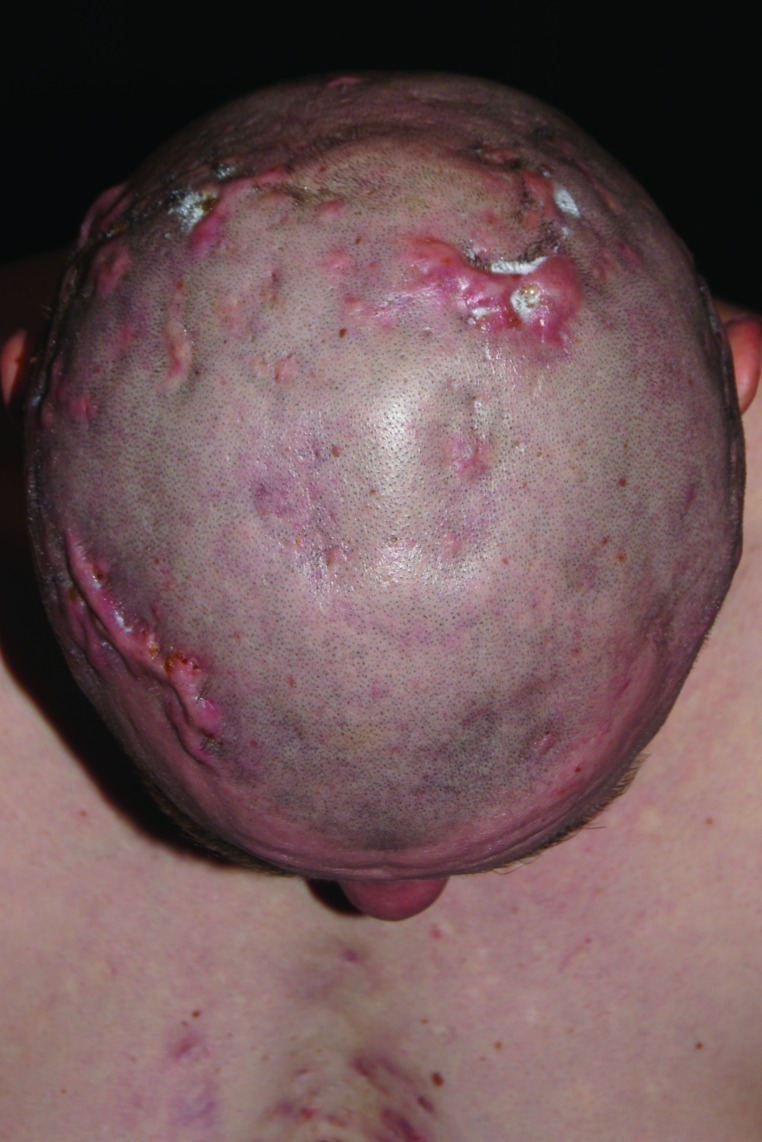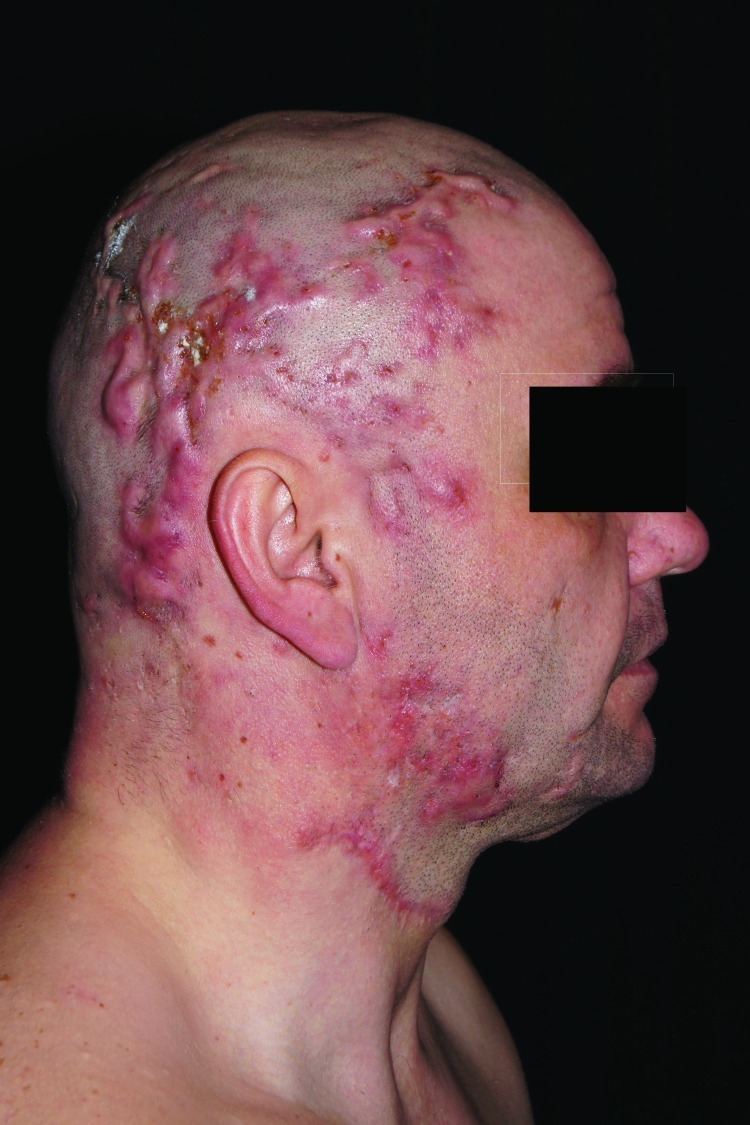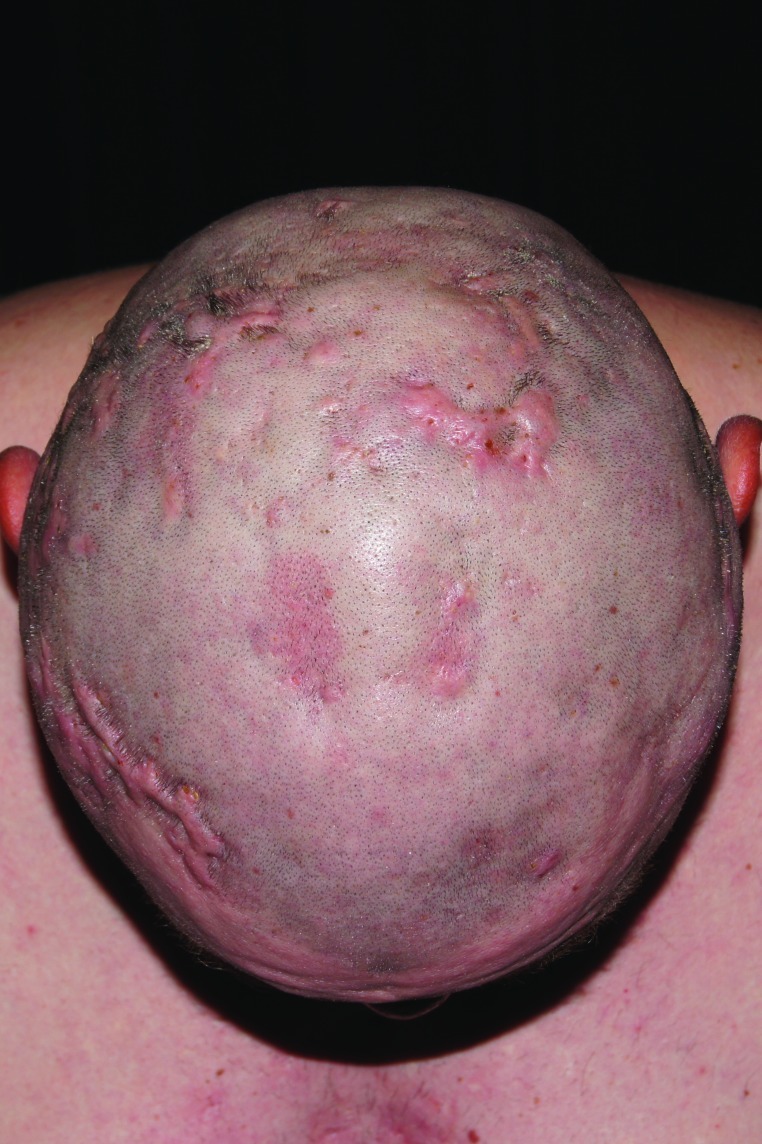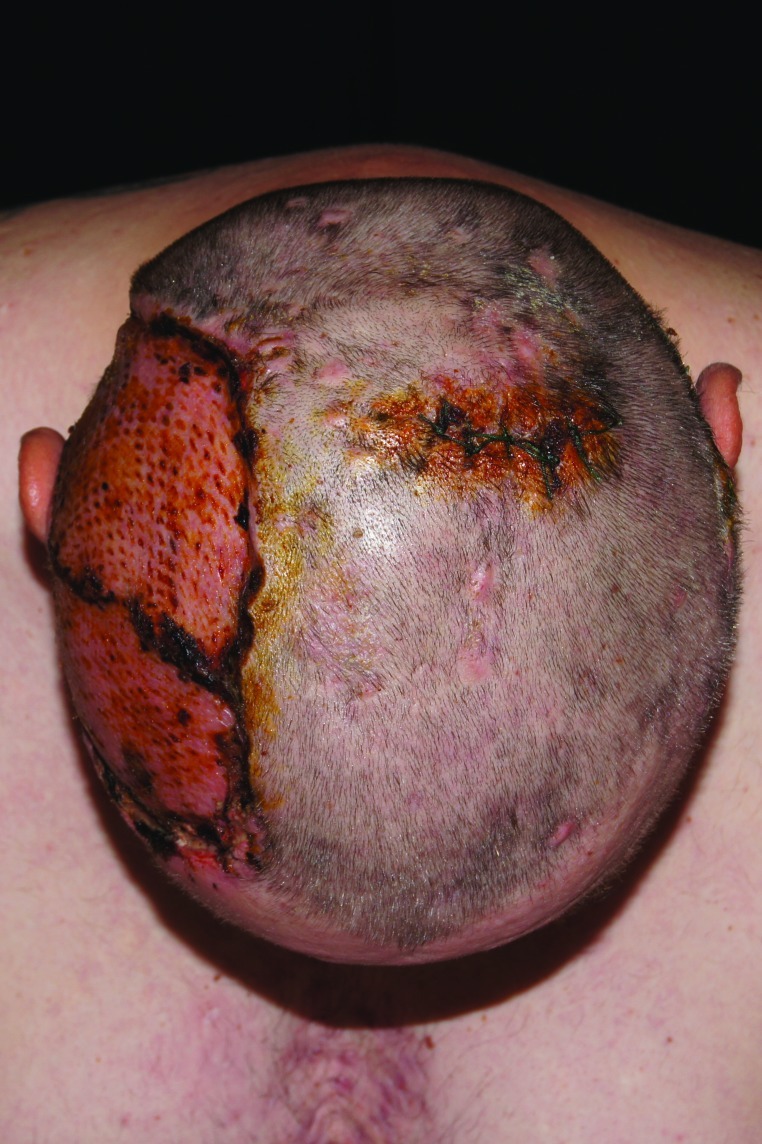Abstract
The authors present the case of a 30-year-old male patient with a severe and long-standing dissecting cellulitis of the scalp. The disease did not respond to conventional treatment, including oral antibiotics, isotretinoin, and prednisolone. Quality of life was significantly impaired. After introduction of anti-tumor necrosis factor-alpha treatment (infliximab), the malodorous discharge stopped, inflammation was reduced significantly, nodules became flat, and pain decreased. The treatment was well tolerated although he developed a temporary psoriasiform rash after the second intravenous infusion. In conclusion, anti-tumor necrosis factor-alpha treatment is a new therapeutic option in this severe and recalcitrant disorder.
Dissecting cellulitis (DC) has been described as perifolliculitis capitis abscedens et suffodiens.1 DC can occur in association with acne conglobata and inverse acne as part of the follicular occlusion triad. The early lesions are sterile follicular pustules.2
Follicular hyperkeratosis leads to the occlusion of the follicle ostium followed by a perifollicular inflammatory infiltrate with predominant neutrophils, histiocytes, and lymphocytes. Ongoing inflammation will produce deep abscesses and foreign body granulomas with hair remnants. The formation of sinus tracts is a characteristic phenomenon of advanced disease. Eventually, a scarring alopecia develops, sometimes with keloids as well. Secondary bacterial infection may occur but infection is not a primary event in DC.3
The course is usually chronic with relapses. This rare disease is seen in younger adult men, mostly African Americans and Caucasians. Smoking may be an aggravating factor such as in acne inversa, but exact data are missing. The same is true for prevalence and incidence of DC.2
Treatment is often disappointing. Topical and systemic antibiotics, dapsone, and systemic retinoids are used with isotretinoin showing the best efficacy. Despite temporary success, relapses are common, and permanent complete remission is rare.2,4,5,6,7,8,9 Surgical-wide excision may be necessary in advanced cases.10 Squamous cell carcinoma (SCC) can be a consequence of longstanding severe inflammation, as in acne inversa.11
The authors present a young male patient with severe DC responding to the intravenous tumor necrosis factor-alpha (TNF-α) antibody infliximab.
Case Report
A 30-year-old male patient presented with a one-year history of progressive, severe, inflammatory lesions on his scalp and face. He was a heavy smoker and had type 2 diabetes mellitus.
On examination, the authors observed a widespread scalp inflammation with painful nodules (some soft and oozing; others dense) and a malodorous discharge from multiple enlarged pores of the scalp, cheeks, and mandibular region. Patches of scarring alopecia and keloid-like scars were also present (Figure 1). Nuchal and submandibular lymph nodes were painful and swollen.
Figures 1a.
Dissecting cellulites of the occipital scalp (A) and lateral face (B)
The authors performed diagnostic biopsies from the scalp that demonstrated follicular occlusion, perifollicular lymphoplasma cellular infiltrates with some mast cells. In the deeper dermis putrid abscess formation, fistulations and fibrosis were observed.
Laboratory investigations. Laboratory results were as follows: blood sedimentation rate of 28mm in the first hour, leukocytosis of 12.8Gpt/L (normal range 3.8–11.0Gpt/L), C-reactive protein 14.2mg/L (normal range <5mg/L).
Microbiological investigations. Microbiological investigations showed mostly leukocytes and sparse gram-positive cocci. The diagnosis DC with acne conglobata was confirmed based on clinical and laboratory data.
Treatment. Initially, the authors treated the patient with 300mg rifampicin, 50mg prednisolone, and 30mg/d of isotretinoin. The pred-nisolone dose was tapered down. The patient responded with a mild improvement. During the following months, pain severity increased again. The pain medication, as suggested by the authors’ pain management clinic, comprised 600mg ibuprofen three times per day, 20gtt/d metamizol four times per day, and 25mg amitriptylin at night. Minor surgery was performed for the most painful nodules. Eventually, scarring alopecia and malodorous discharge continued. The patient reported problems in the family and at work and was experiencing suicidal ideation. He felt severely stigmatized and isolated. Quality of life was significantly reduced.
After informed consent and negative tuberculosis (TB) screening (x-ray of the lungs and TB-spot), the authors started intravenous (IV) therapy with infliximab (Remicade®; MSD, Munich, Germany) 5mg/kg body weight at Weeks 0, 2, and 6. They observed a significant improvement with marked reduced inflammation, secretion, and pain and reduction of nodules even after the first treatment (Figure 2). C-reactive protein level dropped from 19.1mg/L to 2.6mg/L. There was further improvement thereafter and the lymph node swelling completely disappeared. The patient’s mood improved and the scarring process stopped. After the second treatment, he developed a mixed lichenoid and vesicular exanthema. Histopathological examination revealed psoriasiform spongiotic dermatitis with leukocyte-rich pustules. The differential diagnosis was psoriasiform exanthema induced by TNF-α inhibitor. The rash healed completely within several days by topical prednicarbate ointment. The third IV infusion of infliximab was well tolerated and improved the situation further so that surgery could be performed (Figure 3).
Figure 2.
Presentation after intravenous infliximab therapy with significant clinical improvement; occipital (A); temporofrontal (B)
Figure 3.
Three weeks after partial scalp excision with split-skin mesh graft
Discussion
Infliximab is a chimerical monoclonal human/mouse antibody inhibiting both soluble and transmembraneous forms of TNF-α.12 Infliximab and other TNF-α inhibitors have been used successfully in several patients with acne inversa.13 Since DC is characterized by abscess formation and fistulation, it is noteworthy that complex perianal fistulas in Crohn’s disease seem to heal faster and relapse later when infliximab is added to surgery.14
The authors used infliximab in a 30-year-old male patient with DC who was not responding to standard treatment with antibiotics, minor surgery, and retinoids. The primary goal was to control suppurative inflammation. During treatment, it became clear that another option for TNF-α inhibition in this stigmatizing disease is to minimize surgery. In this case, the patient would not have responded to anti-TNF-α therapy, a wide excision of his scalp skin with split-skin mesh graft transplantation would have been necessary, but there were more lesions on his face and neck to be treated. The rapid and profound response to TNF-α-inhibition was beneficial for him. Nevertheless, anti-TNF-α therapy is not curative, but palliative. Therefore, wide excision with primary closure was performed eventually. Healing was fast and uncomplicated.
Between the second and third IV infusion, a rash developed with psoriasiform features. It is known from other indications that all TNF-α can induce psoriasiform exanthemata and palmoplantar psoriasis. The mechanism for this is not well understood.15 One other case report has been published on successful infliximab use for the treatment of DC (Table 1) with complete remission that was stable for at least 12 months after drug withdrawal.16
TABLE 1.
Cases of dissecting cellulitis treated with infliximab
| PATIENT | AGE (YEARS)/GENDER | DURATION (YEARS) | PRETREATMENTS | TREATMENT | OUTCOME | REFERENCE |
|---|---|---|---|---|---|---|
| 1 | 24/male | 4 | dapsone ciprofloxacin isotretinoin | 6x infliximab (5mg/kg) | complete remission after 1-year follow up | Brandt et al (2008)16 |
| 2 | 30/male | 1 | rifampicin prednisolone isotretinoin | 3x infliximab (5mg/kg) | nearly complete remission at 3-month follow up | Present case |
In conclusion, infliximab has been used successfully in the patient with severe recalcitrant DC described in this case. It both promoted fast healing and prevented the patient from having to undergo extensive surgery of the scalp.
Footnotes
DISCLOSURE:Dr. Wollina has given lectures for Abbot, MSD, and Pfizer. Drs. Gemmeke and Koch report no relevant conflicts of interest.
References
- 1.Hoffmann E. Perifolliculitis capitis abscedens et suffodiens: Ein Fallbericht. Dermatol Z. 1908;15:122–123. [Google Scholar]
- 2.Scheinfeld NS. A case of dissecting cellulitis and review of the literature. Dermatol Online J. 2003;9:8. [PubMed] [Google Scholar]
- 3.Stefanato CM. Histopathology of alopecia: a clinicopathological approach to diagnosis. Histopathology. 2010;56:24–38. doi: 10.1111/j.1365-2559.2009.03439.x. [DOI] [PubMed] [Google Scholar]
- 4.Georgala S, Korfitis C, Ioannidu D, et al. Dissecting cellulitis of the scalp treated with rifampicin and isotretinoin: case reports. Cutis. 2008;82:195–198. [PubMed] [Google Scholar]
- 5.Bolz S, Jappe U, Hartschuh W. Successful treatment of perifolliculitis abscedens et suffodiens with combined isotretinoin and dapsone. J Dtsch Dermatol Ges. 2008;6:44–47. doi: 10.1111/j.1610-0387.2007.06399.x. [DOI] [PubMed] [Google Scholar]
- 6.Ljubojevic S, Pasic A, Lipozenzic J, Skerlev M. Perifolliculitis capitis abscendens et suffodiens. J Eur Acad Dermatol Venereol. 2005;19:719–721. doi: 10.1111/j.1468-3083.2005.01215.x. [DOI] [PubMed] [Google Scholar]
- 7.Karpouzis A, Giatromanolakia A, Sivridis E, Kouskoukis C. Perifolliculitis capitis abscedens et suffodiens successfully controlled with topical isotretinoin. J Eur Acad Dermatol Venereol. 2003;13:192–195. [PubMed] [Google Scholar]
- 8.Koca R, Altinyazar HC, Ozen OI, Tekin NS. Dissecting cellulitis in a white male: response to isotretinoin. Int J Dermatol. 2002;41:509–513. doi: 10.1046/j.1365-4362.2002.01552_3.x. [DOI] [PubMed] [Google Scholar]
- 9.Sivakumaran S, Meyer P, Burrows NP. Dissecting folliculitis of the scalp with marginal keratitis. Clin Exp Dermatol. 2001;26:490–492. doi: 10.1046/j.1365-2230.2001.00872.x. [DOI] [PubMed] [Google Scholar]
- 10.Bachynsky T, Antonyshyn ON, Ross JB. Dissecting folliculitis of the scalp. A case report of combined treatment using tissue expansion, radical excision, and isotretinoin. J Dermatol Surg Oncol. 1992;18:877–880. doi: 10.1111/j.1524-4725.1992.tb02920.x. [DOI] [PubMed] [Google Scholar]
- 11.Curry SS, Gaither DH, King LE., Jr. Squamous cell carcinoma arising in dissecting perifolliculitis of the scalp. A case report and review of secondary squamous cell carcinomas. J Am Acad Dermatol. 1981;4:673–678. doi: 10.1016/s0190-9622(81)70068-9. [DOI] [PubMed] [Google Scholar]
- 12. Silva LC, Ortigosa LC, Bernard G. Anti-TNF-α agents in the treatment of immune-mediated inflammatory diseases: mechanisms of action and pitfalls Immunotherapy. 2010. 2 817 833 [DOI] [PubMed] [Google Scholar]
- 13.Delage M, Samimi M, Atlan M, et al. Efficacy of infliximab for hidradenitis suppurativa: assessment of clinical and biological inflammatory markers. Acta Derm Venereol. 2011;91:169–171. doi: 10.2340/00015555-1025. [DOI] [PubMed] [Google Scholar]
- 14.Sciaudone G, Di Stazio C, Limongelli P, et al. Treatment of complex perianal fistulas in Crohn’s disease: infliximab, surgery or combined approach. Can J Surg. 2010;53:299–304. [PMC free article] [PubMed] [Google Scholar]
- 15.Wollina U, Hansel G, Koch A, et al. Tumor necrosis factor-α inhibitor-induced psoriasis or psoriasiform exanthemata. First 120 cases from the literature including a series of six new patients. Am J Clin Dermatol. 2008;9:1–14. doi: 10.2165/00128071-200809010-00001. [DOI] [PubMed] [Google Scholar]
- 16.Brandt HR, Malheiros AP, Teixeira MG, Machado MC. Perifolliculitis abscedens et suffodiens successfully controlled with infliximab. Br J Dermatol. 2008;159:506–507. doi: 10.1111/j.1365-2133.2008.08674.x. [DOI] [PubMed] [Google Scholar]







